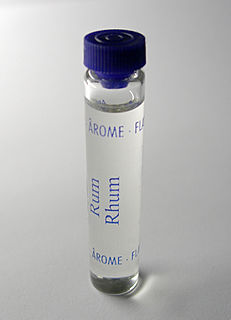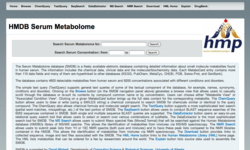Related Research Articles

A flavoring, also known as flavor or flavorant, is a food additive used to improve the taste or smell of food. It changes the perceptual impression of food as determined primarily by the chemoreceptors of the gustatory and olfactory system. Along with additives, other components like sugars determine the taste of food.

An aroma compound, also known as an odorant, aroma, fragrance or flavoring, is a chemical compound that has a smell or odor. For an individual chemical or class of chemical compounds to impart a smell or fragrance, it must be sufficiently volatile for transmission via the air to the olfactory system in the upper part of the nose. As examples, various fragrant fruits have diverse aroma compounds, particularly strawberries which are commercially cultivated to have appealing aromas, and contain several hundred aroma compounds.

The metabolome refers to the complete set of small-molecule chemicals found within a biological sample. The biological sample can be a cell, a cellular organelle, an organ, a tissue, a tissue extract, a biofluid or an entire organism. The small molecule chemicals found in a given metabolome may include both endogenous metabolites that are naturally produced by an organism as well as exogenous chemicals that are not naturally produced by an organism.

Linalool refers to two enantiomers of a naturally occurring terpene alcohol found in many flowers and spice plants. Linalool has multiple commercial applications, the majority of which are based on its pleasant scent. A colorless oil, linalool is classified as an acyclic monoterpenoid. In plants, it is a metabolite, a volatile oil component, an antimicrobial agent, and an aroma compound. Linalool has uses in manufacturing of soaps, fragrances, food additives as flavors, household products, and insecticides.
PubChem is a database of chemical molecules and their activities against biological assays. The system is maintained by the National Center for Biotechnology Information (NCBI), a component of the National Library of Medicine, which is part of the United States National Institutes of Health (NIH). PubChem can be accessed for free through a web user interface. Millions of compound structures and descriptive datasets can be freely downloaded via FTP. PubChem contains multiple substance descriptions and small molecules with fewer than 100 atoms and 1000 bonds. More than 80 database vendors contribute to the growing PubChem database.

Borneol is a bicyclic organic compound and a terpene derivative. The hydroxyl group in this compound is placed in an endo position. Being chiral, borneol exists as two enantiomers. Both (+)-borneol and (−)-borneol (l-borneol) are found in nature.
The DrugBank database is a comprehensive, freely accessible, online database containing information on drugs and drug targets created and maintained by the University of Alberta and The Metabolomics Innovation Centre located in Alberta, Canada. As both a bioinformatics and a cheminformatics resource, DrugBank combines detailed drug data with comprehensive drug target information. DrugBank has used content from Wikipedia; Wikipedia also often links to Drugbank, posing potential circular reporting issues.

KEGG is a collection of databases dealing with genomes, biological pathways, diseases, drugs, and chemical substances. KEGG is utilized for bioinformatics research and education, including data analysis in genomics, metagenomics, metabolomics and other omics studies, modeling and simulation in systems biology, and translational research in drug development.

ChemSpider is a database of chemicals. ChemSpider is owned by the Royal Society of Chemistry.
The ChemDB HIV, Opportunistic Infection and Tuberculosis Therapeutics Database is a publicly available tool developed by the National Institute of Allergy and Infectious Diseases to compile preclinical data on small molecules with potential therapeutic action against HIV/AIDS and related opportunistic infections.

The Human Metabolome Database (HMDB) is a comprehensive, high-quality, freely accessible, online database of small molecule metabolites found in the human body. Created by the Human Metabolome Project funded by Genome Canada. One of the first dedicated metabolomics databases, the HMDB facilitates human metabolomics research, including the identification and characterization of human metabolites using NMR spectroscopy, GC-MS spectrometry and LC/MS spectrometry. To aid in this discovery process, the HMDB contains three kinds of data: 1) chemical data, 2) clinical data, and 3) molecular biology/biochemistry data. The chemical data includes 41,514 metabolite structures with detailed descriptions along with nearly 10,000 NMR, GC-MS and LC/MS spectra.

The Toxin and Toxin-Target Database (T3DB), also known as the Toxic Exposome Database, is a freely accessible online database of common substances that are toxic to humans, along with their protein, DNA or organ targets. The database currently houses nearly 3,700 toxic compounds or poisons described by nearly 42,000 synonyms. This list includes various groups of toxins, including common pollutants, pesticides, drugs, food toxins, household and industrial/workplace toxins, cigarette toxins, and uremic toxins. These toxic substances are linked to 2,086 corresponding protein/DNA target records. In total there are 42,433 toxic substance-toxin target associations. Each toxic compound record (ToxCard) in T3DB contains nearly 100 data fields and holds information such as chemical properties and descriptors, mechanisms of action, toxicity or lethal dose values, molecular and cellular interactions, medical information, NMR an MS spectra, and up- and down-regulated genes. This information has been extracted from over 18,000 sources, which include other databases, government documents, books, and scientific literature.
The Small Molecule Pathway Database (SMPDB) is a comprehensive, high-quality, freely accessible, online database containing more than 600 small molecule pathways found in humans. SMPDB is designed specifically to support pathway elucidation and pathway discovery in metabolomics, transcriptomics, proteomics and systems biology. It is able to do so, in part, by providing colorful, detailed, fully searchable, hyperlinked diagrams of five types of small molecule pathways: 1) general human metabolic pathways; 2) human metabolic disease pathways; 3) human metabolite signaling pathways; 4) drug-action pathways and 5) drug metabolism pathways. SMPDB pathways may be navigated, viewed and zoomed interactively using a Google Maps-like interface. All SMPDB pathways include information on the relevant organs, subcellular compartments, protein cofactors, protein locations, metabolite locations, chemical structures and protein quaternary structures. Each small molecule in SMPDB is hyperlinked to detailed descriptions contained in the HMDB or DrugBank and each protein or enzyme complex is hyperlinked to UniProt. Additionally, all SMPDB pathways are accompanied with detailed descriptions and references, providing an overview of the pathway, condition or processes depicted in each diagram. Users can browse the SMPDB or search its contents by text searching, sequence searching, or chemical structure searching. More powerful queries are also possible including searching with lists of gene or protein names, drug names, metabolite names, GenBank IDs, Swiss-Prot IDs, Agilent or Affymetrix microarray IDs. These queries will produce lists of matching pathways and highlight the matching molecules on each of the pathway diagrams. Gene, metabolite and protein concentration data can also be visualized through SMPDB's mapping interface.
MetaboAnalyst is a set of online tools for metabolomic data analysis and interpretation, created by members of the Wishart Research Group at the University of Alberta. It was first released in May 2009 and version 2.0 was released in January 2012. MetaboAnalyst provides a variety of analysis methods that have been tailored for metabolomic data. These methods include metabolomic data processing, normalization, multivariate statistical analysis, and data annotation. The current version is focused on biomarker discovery and classification.

Ethane-1,1-dithiol is an organosulfur compound with formula CH3CH(SH)2. It is a colourless smelly liquid that is added to or found in some foods. The compound is an example of a geminal dithiol.
The Yeast Metabolome Database (YMDB) is a comprehensive, high-quality, freely accessible, online database of small molecule metabolites found in or produced by Saccharomyces cerevisiae. The YMDB was designed to facilitate yeast metabolomics research, specifically in the areas of general fermentation as well as wine, beer and fermented food analysis. YMDB supports the identification and characterization of yeast metabolites using NMR spectroscopy, GC-MS spectrometry and Liquid chromatography–mass spectrometry. The YMDB contains two kinds of data: 1) chemical data and 2) molecular biology/biochemistry data. The chemical data includes 2027 metabolite structures with detailed metabolite descriptions along with nearly 4000 NMR, GC-MS and LC/MS spectra.
Metabolite Set Enrichment Analysis (MSEA) is a method designed to help metabolomics researchers identify and interpret patterns of metabolite concentration changes in a biologically meaningful way. It is conceptually similar to another widely used tool developed for transcriptomics called Gene Set Enrichment Analysis or GSEA. GSEA uses a collection of predefined gene sets to rank the lists of genes obtained from gene chip studies. By using this “prior knowledge” about gene sets researchers are able to readily identify significant and coordinated changes in gene expression data while at the same time gaining some biological context. MSEA does the same thing by using a collection of predefined metabolite pathways and disease states obtained from the Human Metabolome Database. MSEA is offered as a service both through a stand-alone web server and as part of a larger metabolomics analysis suite called MetaboAnalyst.

The Serum Metabolome database is a free web database about small molecule metabolites found in human serum and their concentration values. The database includes chemical data, clinical data and molecular/biochemistry data from literature and experiment. This database also references many other databases, such as KEGG, PubChem, MetaCyc, ChEBI, PDB, Swiss-Prot, GenBank, and Human Metabolome Database (HMDB).
The E. coli Metabolome Database (ECMDB) is a comprehensive, high-quality, freely accessible, online database of small molecule metabolites found in or produced by Escherichia coli. Escherichia coli is perhaps the best studied bacterium on earth and has served as the "model microbe" in microbiology research for more than 60 years. The ECMDB is essentially an E. coli "omics" encyclopedia containing detailed data on E. coli's genome, proteome and its metabolome. ECMDB is part of a suite of organism-specific metabolomics databases that includes DrugBank, HMDB, YMDB and SMPDB. As a metabolomics resource, the ECMDB is designed to facilitate research in the area gut/microbiome metabolomics and environmental metabolomics. The ECMDB contains two kinds of data: 1) chemical data and 2) molecular biology and/or biochemical data. The chemical data includes more than 2700 metabolite structures with detailed metabolite descriptions along with nearly 5000 NMR, GC-MS and LC-MS spectra corresponding to these metabolites. The biochemical data includes nearly 1600 protein sequences and more than 3100 biochemical reactions that are linked to these metabolite entries. Each metabolite entry in the ECMDB contains more than 80 data fields with approximately 65% of the information being devoted to chemical data and the other 35% of the information devoted to enzymatic or biochemical data. Many data fields are hyperlinked to other databases. The ECMDB also has a variety of structure and pathway viewing applets. The ECMDB database offers a number of text, sequence, spectral, chemical structure and relational query searches. These are described in more detail below.

David S. Wishart FRSC is a Canadian researcher and a Distinguished University Professor in the Department of Biological Sciences and the Department of Computing Science at the University of Alberta, where he has been since 1995. Wishart also holds cross appointments in the Faculty of Pharmacy and Pharmaceutical Sciences and the Department of Laboratory Medicine and Pathology in the Faculty of Medicine and Dentistry. Additionally, Wishart holds a joint appointment in metabolomics at the Pacific Northwest National Laboratory in Richland, Washington. Wishart is well known for his pioneering contributions to the fields of protein NMR spectroscopy, bioinformatics, cheminformatics and metabolomics. In 2011, Wishart founded and currently serves as a co-director of he Metabolomics Innovation Centre (TMIC), which is Canada's national metabolomics laboratory.
References
- 1 2 Scalbert, A.; Andres-Lacueva, C.; Arita, M.; Kroon, P.; Manach, C.; Urpi-Sarda, M.; Wishart, D.S. (2011). "Databases on Food Phytochemicals and Their Health-Promoting Effects". J. Agric. Food Chem. 59 (9): 4331–4348. doi:10.1021/jf200591d. PMID 21438636.
- 1 2 Wishart, D. S.; Knox, C.; Guo, A.; Eisner, A.; Young, N.; Gautam, B.; Hau, D. D.; Psychogios, N.; Dong, E.; Bouatra, S.; Mandal, R.; Sinelnikov, I.; Xia, J.; Jia, L.; Cruz, J. A.; Lim, E.; Sobsey, C. A.; Shrivastava, S.; Huang, P.; Liu, P.; Fang, L.; Peng, J.; Fradette, R.; Cheng, D.; Tzur, D.; Clements, M.; Lewis, A.; Souza, A. D.; Zuniga, A.; Dawe, M.; Xiong, Y.; Clive, D.; Greiner, R.; Nazyrova, A.; Shaykhutdinov, R.; Li, L.; Vogel, H. J.; Forsythe, I. (2009). "HMDB: a knowledgebase for the human metabolome". Nucleic Acids Research. 37 (Database issue): D603–D610. doi:10.1093/nar/gkn810. PMC 2686599 . PMID 18953024.